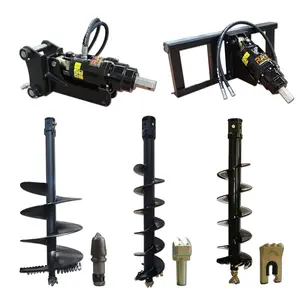

Hydraulic Ground Earth Auger Drive And Drill Price For Excavator Skid Steer Backhoe Loader Crane Tractor








Horizontal directional drilling (HDD), a method of underground drilling, has revolutionized the way subsurface utilities and infrastructure are installed. This trenchless technology is utilized for the installation of pipelines, conduits, and cables with minimal surface disruption. The versatility of horizontal directional drilling machines makes them suitable for a variety of soil conditions and applications.
The horizontal directional drill is designed to cater to diverse drilling needs. From directional bore drilling for small-scale projects such as residential utilities to large-scale underground drilling operations for municipal services, these drills offer a range of capabilities. The application of HDD technology spans from water and gas distribution to telecommunications and power line installations. The adaptability of these machines allows for horizontal drilling in environments where traditional excavation methods are impractical or impossible.
A typical horizontal directional boring machine comprises advanced features to enhance its functionality. These include varying propulsion systems, such as caterpillar treads suitable for steep inclines, and rubber tires for easy transport. The construction of these machines often involves robust materials capable of withstanding the rigors of drilling operations. Drill bits, a critical component, come in various shapes and materials, including diamond and alloy compositions, to match the specific requirements of the drilling process.
The advantages of hdd horizontal directional drilling are manifold. It offers a non-invasive method to lay pipes and cables, preserving the integrity of landscapes and existing structures. Efficiency is another benefit, as HDD can complete installations faster than traditional methods. Furthermore, the precision of directional drilling minimizes the risk of damaging existing underground utilities, leading to safer construction environments.
When selecting a horizontal directional drilling machine, it is essential to consider the specifications such as drilling depth, hole diameter, and the power of the machine, which dictate the drilling speed and efficiency. Equipment accompanying the drill, like air compressors, mud pumps, and drilling rods, plays a significant role in the drilling operation's success. The choice of drill bit, whether it's a PDC or a hammer bit, is determined by the drilling method required, such as rotary or percussion.
Selecting the appropriate horizontal directional drill is crucial for the success of any drilling project. Factors such as the scale of the project, the terrain, and the material to be drilled should guide the decision. While smaller HDD units are apt for projects like farm irrigation systems, larger, more powerful rigs are designed for extensive underground directional boring tasks. It is important to assess the scope of work to determine the most suitable HDD equipment for efficient and effective drilling outcomes.